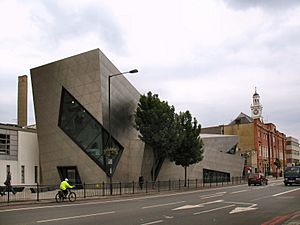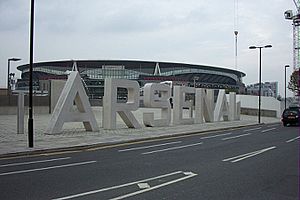Holloway, London facts for kids
Quick facts for kids Holloway |
|
|---|---|
 Junction of Holloway Road and Seven Sisters Road in central Holloway |
|
| OS grid reference | TQ306859 |
| • Charing Cross | 3.3 mi (5.3 km) S |
| London borough | |
| Ceremonial county | Greater London |
| Region | |
| Country | England |
| Sovereign state | United Kingdom |
| Post town | LONDON |
| Postcode district | N7, N19 |
| Dialling code | 020 |
| Police | Metropolitan |
| Fire | London |
| Ambulance | London |
| EU Parliament | London |
| UK Parliament |
|
| London Assembly |
|
Holloway is a lively area in north London, England. It's about 5.3 kilometers (3.3 miles) north of Charing Cross, following the path of the Holloway Road (which is part of the A1). At its heart is the Nag's Head shopping area. This sits between the quieter, more residential parts called Upper Holloway and Lower Holloway. Holloway is known for its diverse population and is home to the Emirates Stadium, where Arsenal F.C. plays. Until 2016, it was also the location of Holloway Prison, which was once the largest women's prison in Europe. Before 1965, Holloway was part of the historic county of Middlesex.
Contents
History of Holloway
The exact meaning of the name "Holloway" is a bit of a mystery. Some people think it comes from "Hollow way." This might be because the road had a dip in it. This dip could have been caused by many animals walking on it or by water washing away the soil. This road was a main path for driving cattle from the North into Smithfield market. In Lower Holloway, an old road called Back Road (now Liverpool Road) was used for cattle to rest before entering London.
Others believe the name comes from "Hallow," meaning holy. They think it refers to the road being part of a pilgrimage route to Walsingham. However, there's no old document to prove either idea. By 1307, the area around the road was already known as Holwey. The main part of Holloway Road goes through where two old villages, Tollington and Stroud, used to be. We don't know exactly when they were founded, but they are mentioned in the Domesday Book, a very old survey from 1086. These village names stopped being used by the late 1600s. But you can still find them in local names like Tollington Park and Stroud Green.
The first road from London went through Tollington Lane. But by the 1300s, this road was in such bad shape that the Bishop of London built a new one up Highgate Hill. By 1318, he was charging tolls to use it. This was the beginning of the Great North Road, which is now the A1 and runs through Holloway.
How Holloway Grew
Until the 1700s, Holloway was mostly countryside. But as London grew in the late 1800s, it became very built-up. Holloway, like many parts of inner north London, grew quickly around the early 1900s. It soon became an important local shopping area. This was helped by the Nag's Head road junction. It became a busy spot for trolleybus services until they stopped in the 1950s.
The London and North Eastern Railway opened a train station here. This greatly helped the area grow with more homes and shops in the late 1800s. This station is now closed, but it was in the same place as the current Holloway Road tube station, which is on the Piccadilly line.
In the late 1930s, the Odeon cinema was built at the junction of Tufnell Park Road and Holloway Road. It was badly damaged by a doodlebug during the Second World War. It has recently been fixed up but still has its impressive entrance and staircase. It is a Grade II listed building, meaning it's protected for its historical importance.
During the Second World War, parts of Holloway were heavily bombed. This was because it was close to King's Cross railway station, an important transport hub.
Holloway was also home to HMP Holloway on Parkhurst Road. It was first built in 1852. At first, it held both men and women. But from 1902, it only held women and became the UK's main prison for women. It closed in 2016.
Holloway Today

Like other parts of Islington, Holloway is seeing many changes. Newer, nicer buildings are being built, especially in the Hillmarton and Mercers Road/Tavistock Terrace areas. There are also many new building projects happening near the Arsenal stadium and Caledonian Road. The Islington London Borough Council also plans to improve the Nag's Head area over the next ten years. Holloway is also home to the large Andover housing estate.
Near Holloway Road tube station is the North Campus of London Metropolitan University. This includes the Tower building, Stapleton House, and the Learning Centre. Another very noticeable feature in Holloway is the Emirates Stadium, which is the home of Arsenal F.C..
Many artists and people who work in media live in Holloway. This includes journalists, writers, and people working in film and television. It's also known as a popular spot for London's graffiti artists.
Population and Diversity
At the 2001 census, Holloway had a population of 41,329 people. About 48% were male and 52% were female. Holloway is home to a very multicultural population, meaning people from many different backgrounds live there. In 2011, the Holloway ward had: 42% white British, 21% from other white backgrounds, 7% mixed race, 14% Black, and 11% Asian. The number of people from mixed race backgrounds is among the highest in the country. It is one of the most crowded areas of London, with about 40,000 people living in each square mile.
Famous People from Holloway
Many interesting people have lived in Holloway, including:
- Jimmi Harkishin (born 1969), an actor known for Coronation Street.
- Edward Lear (1812–1888), an artist, illustrator, writer, and poet. He was born and grew up in Holloway.
- Joe Meek (1929–1967), a record producer and sound engineer. He lived, worked, and died at 304 Holloway Road.
- Steve Howe (born 1947), a guitarist for the bands Yes and Asia. He was born and lived in Loraine Mansions during his teenage years.
- David Littlewood (born 1955), a cricketer.
- Kaya Scodelario, an actress.
- Douglas Adams, an author who wrote The Hitchhiker's Guide to the Galaxy at 19 Kingsdown Road.
- Christian Wolmar, an author, railway historian, and politician.
Emirates Stadium (Ashburton Grove)
Arsenal Football Club moved to a new stadium in Holloway called Ashburton Grove. They had been at their old stadium, Highbury, for 93 years. The new stadium was informally known as Ashburton Grove until a deal was made with Emirates to name it the Emirates Stadium. The stadium opened in the summer of 2006. It has seats for 60,355 people, making it the third biggest stadium in the Premiership (after Old Trafford and the Tottenham Hotspur Stadium). It's also the fourth biggest in London (after Wembley Stadium, Twickenham Stadium, and the Tottenham Hotspur Stadium). The whole project cost about £390 million.
Ashburton Grove used to be the site of Islington's Waste Transfer station. This is where rubbish was collected before being moved elsewhere. This facility has now been moved to Hornsey Street nearby. All of Islington's waste goes here for processing. A lot of waste from the nearby London Boroughs of Camden and Hackney also comes here. The waste is then taken by road to the Edmonton Solid Waste Incineration Plant or to landfill sites in Cambridgeshire and Bedfordshire.
Getting Around Holloway (Transport)
Holloway has many ways to get around.
London Underground Stations
The closest London Underground stations (also known as the Tube) are:
London Overground Stations
The closest London Overground stations are:
- Caledonian Road & Barnsbury
- Camden Road
- Highbury & Islington
- Upper Holloway
Drayton Park railway station is near the southern end of Holloway Road. It is on the Northern City Line.
Bus Routes
Holloway is served by many bus routes, including:
- 4
- 17
- 21
- 29
- 43 (runs 24 hours)
- 91
- 153
- 253
- 254
- 259
- 263
- 393
There are also Night bus routes: N29, N41, N91, N253, and N279.
See also
 In Spanish: Holloway (Londres) para niños
In Spanish: Holloway (Londres) para niños



